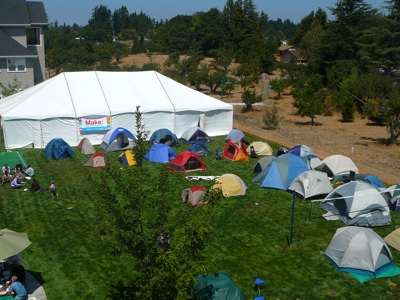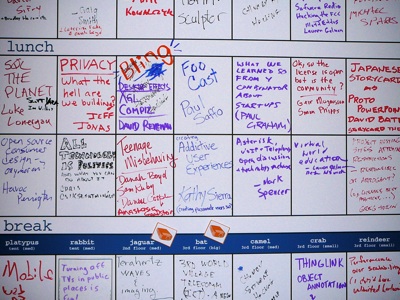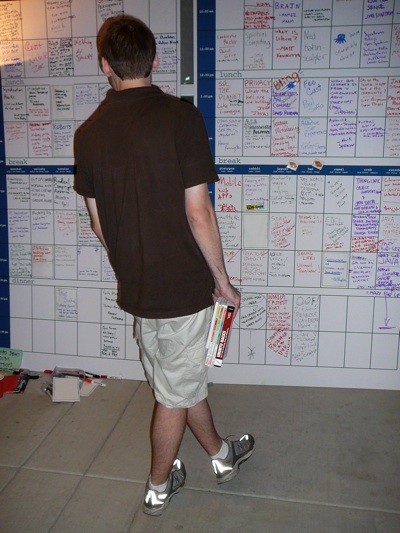BIL, the Unconference
Tomorrow the annual TED conference begins. TED is an intense four or five days of world-class presenters across a wide-range of subjects. While the quality of talks is uneven (for 80 in total this is inevitable), I feel safe in saying that overall TED offers a chance to see the world’s best speakers and highly evolved presentations. In the years I’ve gone, I have not been bored for long.
But TED is a very scripted, controlled, high-priced conference. A ticket costs is $6,000 — if you sign up a year in advance. Recently TED has begun to post favorite past talks online for free, which of course (Better than free!) only makes the live experience more coveted.
![]()
In response to the highly edited and out-of-reach price of TED, a shadow conference has emerged. Called BIL (get it? BIL and TED), this is an unconference that will take place in Monterey, CA (where TED operates) beginning Saturday, this weekend, March 1-2. The schedule is not quite parallel to TED, but it does overlap by a day.
Like most unconferences, BIL is a user-generated meeting. It’s free. Anyone can come. Anyone can present. The agenda and schedule are self-organized starting with a wiki, and a white board at the event.
Some of the speakers signed up for BIL, the free shadow TED, have spoken at TED before, some should speak at TED in the future, and some are people you will never hear at TED. And like all conferences, some who talk should not — but hey, that happens at TED as well. Here are some sample talks now on the agenda:
Millicomputing: The Coolest CPUs and the Flashiest Storage – Adrian Cockcroft
How to Be a Successful Heretic – Aubrey de Grey
An Exceptionally Simple Theory of Everything – A Garrett Lisi
Darknets – fascist gated associations, or intentional community – Baron RK Von Wolfsheild
Always the Next Human – Quinn Norton
Motivation Psychology. Learning Optimism. – Kai Chang
The Rise of the Machines and the End of Transit – Brad Templeton
Stem Cells- Everything You Wanted To Know But Were Afraid to Ask – Daniel Kraft
Sadly I am out of town this week, so while I will be a TED, I will miss BIL. But if you would like an intense, unique learning experience, go to BIL.
Unconferences have a long history. They began as supplimental self-organized birds-of-a-feather meetings at tech conferences. I believe the first Hackers’ Conference we organized in 1984 had BoF meetings. The idea was people with a strong interest would publicly post their passion in meeting other like-minded folks and then the interested parties would self-organize a gathering in the evening hours. Those meetings were often so productive, many folks had a similar idea: forget about speakers at a podium. Just host an entire conference consisting of nothing but self-organized gatherings in small rooms. Tim O’Reilly extended the scale of the gathering to include free camping outside on a lawn in his FooCamp (below).

FooCamp really works. Here is a the matrix white board from the first FooCamp where individuals can sign up their intention to speak at a certain time.

The rest of the gathering will either pick someone to listen to, or sign up to speak themselves. It becomes a free-market of ideas at that point. Popular ideas get a crowded room, less popular ones don’t. One can begin to detect patterns of interest emerging.

FooCamp is invitational, and so it spawned BarCamp, now held all over the world, which are open to anyone. The principles of an unconference (as articulated by Open Space) are:
Whoever comes are the right people.
Whatever happens is the only thing that could have.
Whenever it starts is the right time.
Whenever it is over it is over.
Here is how to organize a powerful unconference. This can work inside a company as well as in public.
1) Establish a venue with many smaller rooms, and a time. You may need to provide food.
2) Post the invitation on a wiki. Let users volunteer to speak, decide the agenda, and get a sense of who is coming using the wiki. There is a BarCamp Wiki template here.
3) At a meeting room during the venue erect a large board with a blank matrix. Attending speakers will sign up for rooms and time slots.
4) Enjoy as people and ideas connect.
OK, it is not really that easy. Someone has to get it going, rent the rooms, cover costs, and make sure folks end on time. For a really great tutorial on how to organize an unconference see Darren Barefoot’s write up.
By miles, these kinds of unconferences have yielded more for me than any other type of meeting. An unconference give the highest ratio of new, unexpected, never-thought-of-that ideas than any other venue I am aware of.

